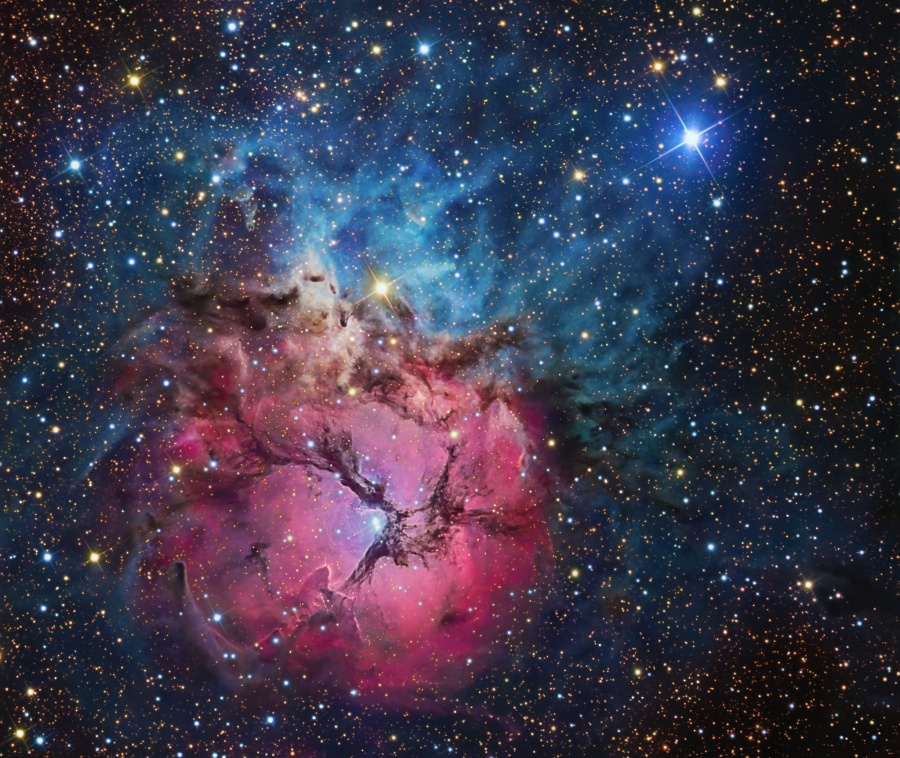Page 1 of 1
APOD: A Beautiful Trifid (2011 May 13)
Posted: Fri May 13, 2011 4:06 am
by APOD Robot
 A Beautiful Trifid
Explanation:
A Beautiful Trifid
Explanation: The beautiful
Trifid Nebula is a
cosmic study in colorful contrasts. Also known as M20, it lies about
5,000 light-years away toward the
nebula rich constellation Sagittarius. A star forming region in the plane of our galaxy, the Trifid illustrates three different types of astronomical nebulae; red
emission nebulae dominated by light emitted by hydrogen atoms, blue
reflection nebulae produced by dust reflecting starlight, and
dark nebulae where dense dust clouds appear in silhouette. The bright red emission region, roughly separated into three parts by obscuring, dark dust lanes, lends the Trifid its popular name. In
this well met scene, the red emission is also juxtaposed with the telltale blue haze of reflection nebulae. Pillars and jets sculpted by newborn stars, below and left of the emission nebula's center, appear in Hubble Space Telescope
close-up images of the region. The Trifid Nebula is about 40 light-years across.
[/b]
Re: APOD: A Beautiful Trifid (2011 May 13)
Posted: Fri May 13, 2011 5:02 am
by islader2
Pshaw, I have done enough CABGs to know that is a diseased heart picture.
Re: APOD: A Beautiful Trifid (2011 May 13)
Posted: Fri May 13, 2011 5:51 am
by Ann
A beautiful Trifid indeed! This is a splendid and incredibly beautiful RGB image, which also contains a lot of information.
Note the blue O-type star in the center of the Trifid which is responsible for powering the nebula. Note how dust close to the hot star reflects the predominantly blue light from this and a few other hot stars in a small cluster. Note how the nebula then changes color, first to soft pink, then to a much deeper magenta-red, and then back to blue again. Note that wisps of blue reflection nebulosity surrounds all of the Trifid Nebula instead of being located only to the north of the red nebula.
Also note that the bright blue reflection nebula seems to be illuminated by a bright yellow star! If that yellow star is the main source of light for the blue reflection nebula, then the yellow star and the blue nebula provide a most excellent example of how stars get reddened when much of their blue light is scattered away when their light is passing through a cloud. But the picture is also a splendid example of how this reflected light scatters back at observers at predominantly blue wavelengths. (Have you ever wondered why the Sun appears to be yellow when the sky is blue?

)
Note how, at the interface of the red and the blue nebula, there is a large yellowish-white patch, which seems to reflect the true yellow-white color of the bright yellow star. But the white patch could be a mixture of light from several light-sources, including light from the blue star at the center of the red nebula.
Also note how there is a very large black patch of dust at the interface of the red and the blue nebula at three o'clock, and how the blue light that seeps through this dark dust has been reddened to a bluish-green hue.
Also note the bright blue star in the upper right part of the picture, at two o'clock. This is undoubtedly a very young, very hot star, which may have been formed out of gas that originally belonged to the same large cloud of gas and dust that has now produced the Trifid Nebula.
I want to thank both R Jay Gabany and the editors of this page for today's very beautiful APOD!

Ann
Re: APOD: A Beautiful Trifid (2011 May 13)
Posted: Fri May 13, 2011 6:06 am
by atalas
I remember this shot of Jay's,just spectacular detail and work! congrats again Jay.
Re: APOD: A Beautiful Trifid (2011 May 13)
Posted: Fri May 13, 2011 7:06 am
by jgabany
Thank you very much Ann and atalas! I really appreciate the compliments and the congratulations!
Re: APOD: A Beautiful Trifid (2011 May 13)
Posted: Fri May 13, 2011 11:04 am
by isoparix
Why doesn't astronomy use radians? Not really on the subject, so apologies, but when I see such (very nice) pictures I always wonder, well how big is that in the sky? Could I capture it via my telescope, how big will the image be on the film? And here, conveniently the object is given as 40 ly across and 5000 ly away, so angular size is (in radians) 1/125. This I can use directly - focal length 1000 mm, image size will be around 8 mm (1000/125 mm). Fine - trivial arithmetic. But if I were to look up angular size of Trifid Nebula I'd be told it was around 28 arc-minutes. Great if I want to compare it mentally against other arc-minuted objects, but a real pain if I want to use for practical purposes, because I then have to convert from arc-seconds/minutes to a usable angle - in radians. So why not start from there? A lost cause, of course.
Re: APOD: A Beautiful Trifid (2011 May 13)
Posted: Fri May 13, 2011 12:20 pm
by biddie67
Seems like a good function for one of those apps ...
Re: APOD: A Beautiful Trifid (2011 May 13)
Posted: Fri May 13, 2011 12:38 pm
by geckzilla
isoparix - a lot of the time a good comparison is the moon. In this case, Trifid is a little smaller than the full moon in the sky. I've found that way of describing it to be the easiest in layman's terms. As for using radians or not... no idea.
Edit: here's a Wikipedia article that might help:
http://en.wikipedia.org/wiki/Minute_of_arc
I gather radians aren't practical to use because the angles are often so small.
Re: APOD: A Beautiful Trifid (2011 May 13)
Posted: Fri May 13, 2011 12:57 pm
by neufer
isoparix wrote:
Why doesn't astronomy use radians? Not really on the subject, so apologies, but when I see such (very nice) pictures I always wonder, well how big is that in the sky? Could I capture it via my telescope, how big will the image be on the film? And here, conveniently the object is given as 40 ly across and 5000 ly away, so angular size is (in radians) 1/125. This I can use directly - focal length 1000 mm, image size will be around 8 mm (1000/125 mm). Fine - trivial arithmetic. But if I were to look up angular size of Trifid Nebula I'd be told it was around 28 arc-minutes. Great if I want to compare it mentally against other arc-minuted objects, but a real pain if I want to use for practical purposes, because I then have to convert from arc-seconds/minutes to a usable angle - in radians. So why not start from there? A lost cause, of course.
So the Trifid Nebula M20 is 1/125 the distance to the Trifid Nebula M20...whatever that is:
http://www.seds.org/messier/m/m020.html wrote:
<<The [Trifid Nebula M20] nebula's distance is rather uncertain, with values between 2,200 light years (Mallas/Kreimer; Glyn Jones has 2,300) and about 7,600 light years (C.R. O'Dell 1963). The Sky Catalog 2000 gives 5,200 light years, a value which is also used by Archinal and Hynes (2003), and which we adopt here>>
http://www.cosmotography.com/images/cosmic_nurseries.html wrote:
<<About 9,000 thousand light-years from Earth towards the southern constellation of Sagittarius, the Trifid Nebula (NGC 6514) offers a relevant portrait showing the early stages of a star’s life from conception to birth. Violent winds and extremely high temperatures of newly kindled stars agitate and transform the Trifid's clouds into a seething cauldron of unimaginable proportions. Positioned along our line of site so that it appears to be near the much closer Lagoon Nebula- another stellar cauldron- the Trifid hangs in front of the central region of our galaxy that lies farther behind. As such, thousands of farther stars comprising part of the Milky Way's galactic plane are also seen in this picture. Positioned nearby along our line of site to the Trifid, the Lagoon Nebula is another site of intense new star production but it's almost twice as close.>>
http://galaxymap.org/drupal/node/60 wrote:
<<There are also many bright nebulae in foreground and background to the Omega complex but not too far away in the sky. These include the Lagoon nebula (Sh 2-25, M8) which at a distance of 1250 parsecs is well in front of the Omega complex (and likely connected to the Sagittarius OB1 association) and the Trifid nebula (Sh 2-30, M20) which at 3010 parsecs is slightly behind (News Flash! - it turns out that the Trifid nebula is actually only 816 parsecs away as I describe in this
APOD discussion thread. I'll be moving the Trifid nebula (and many others) on the galaxy map as part of a larger re-organisation of the map based on important new star cluster studies later this year.)>>
Re: APOD: A Beautiful Trifid (2011 May 13)
Posted: Fri May 13, 2011 1:19 pm
by Chris Peterson
isoparix wrote:Why doesn't astronomy use radians?
It's just a matter of convention. While you could argue that the radian is a more "natural" unit for measuring angles, the reality is that it doesn't provide enough advantages over DMS to justify people making a change. The biggest problem with sexagesimal units is simply dealing with non-standard entry methods (this is an issue for hour angles as well). But once converted to a single decimal value, it is as easy to work with degrees as radians, as trivial to calculate field-of-view or pixel scale either way.
Re: APOD: A Beautiful Trifid (2011 May 13)
Posted: Sat May 14, 2011 1:19 pm
by orin stepanek
Beautiful picture!

Really will make a nice wallpaper!

Re: APOD: A Beautiful Trifid (2011 May 13)
Posted: Sat May 14, 2011 4:27 pm
by neufer
orin stepanek wrote:
Really will make a nice wallpaper!


Triffid Wall-paper/flower
Re: APOD: A Beautiful Trifid (2011 May 13)
Posted: Sat May 14, 2011 5:35 pm
by jgabany
Hi Orin:
Thanks for the compliment! I appreciate it! As it happens, I use this picture for my wallpaper, too.
Art, I also thought of that flick when I was working on this project. It's funny, how things get stuck in your head and won't let go. The picture you posted is a classic. A good caption would be : "Aphids!" :>)
Jay
Re: APOD: A Beautiful Trifid (2011 May 13)
Posted: Sat May 14, 2011 5:51 pm
by orin stepanek
Hi Jay; Art's post made me look up the flic. I never saw it; but after watching the trailers; looked interesting. I don't watch the SiFi channel much; but looks like a good candidate.

Congrats on the Trifid.

I remember the Trifid from before; kind of reminds me of a flower.

 A Beautiful Trifid
A Beautiful Trifid
